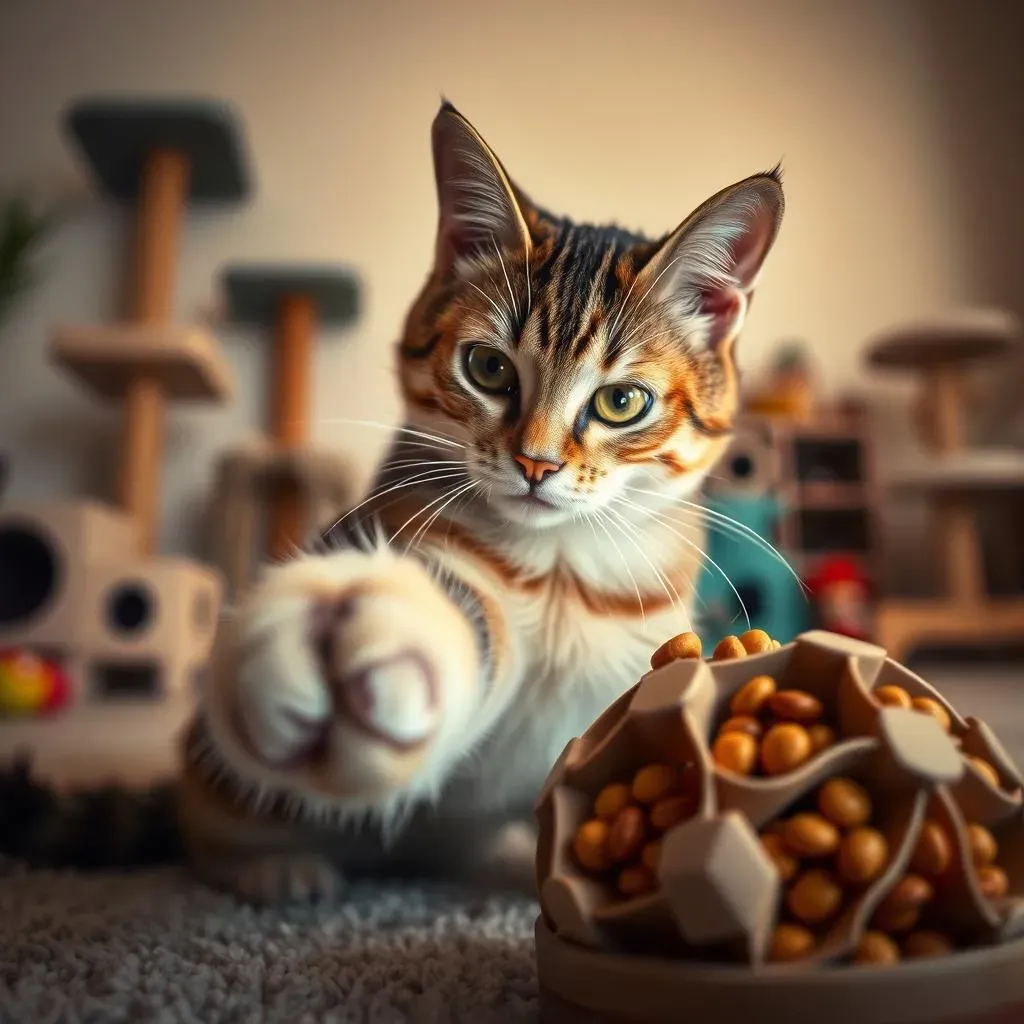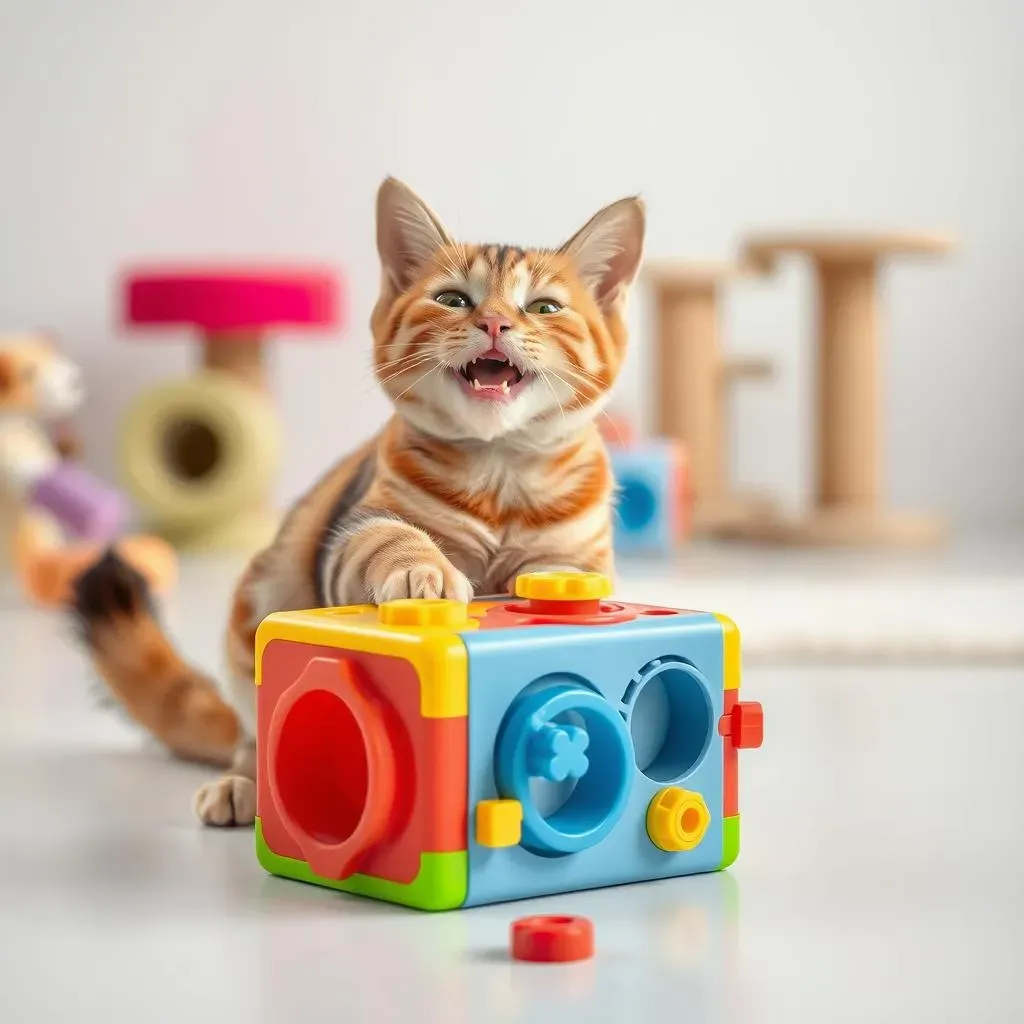Table of Contents
Ever watch your cat stare blankly at a wall, or maybe they're just a little too interested in your ankles? Yeah, me too. They're smart little hunters, and sometimes they need a little more to do than just nap in a sunbeam. That's where the magic of interactive cat puzzle toys comes in. These aren't your average catnip mice; we're talking brain-tickling, treat-dispensing contraptions that can turn your couch potato into a furry little genius (or at least keep them busy for a bit). This article will walk you through why these toys are so great for your feline friend, how to pick the perfect puzzle for their personality, and even some insider tips on making playtime a blast. So, get ready to unleash your cat's inner Sherlock Holmes, and let's explore the world of interactive cat puzzle toys together!
Why Interactive Cat Puzzle Toys Are a MustHave

Why Interactive Cat Puzzle Toys Are a MustHave
Boredom Busters and Brain Boosters
Let's face it, cats are natural hunters, and a life of lounging can get pretty dull. Interactive cat puzzle toys aren't just about keeping them busy, they're about tapping into those instincts. Think of it like giving your cat a mini-mission every day. These toys challenge them to problem-solve, figure out how to get to the treat, and that mental workout is just as important as the physical one. A bored cat can become a destructive cat, so a good puzzle toy can be a lifesaver for your furniture.
It's not just about preventing chaos, though. These toys can also help keep their minds sharp. It's like a crossword puzzle for your cat, but with a tasty reward at the end. A stimulated cat is a happier cat, and we all want happy, right? I’ve seen my own cat, Mittens, go from apathetic to absolute focus when she’s working on her puzzle. It’s like a lightbulb goes off in her furry little head.
The Benefits Beyond the Basics
Beyond the obvious, there are other great reasons to invest in interactive toys. For starters, they can help with weight management. Instead of scarfing down a whole bowl of food in minutes, a puzzle feeder makes them work for each bite, slowing down their eating and helping them feel fuller for longer. This is super helpful if your cat is prone to overeating. Plus, it gives them a sense of accomplishment when they finally get that treat. It’s a little victory for them, and a big win for their health.
These toys can also be a great way to bond with your cat. Even if they're playing solo, you can still be involved by introducing new puzzles, refilling them with treats, and offering encouragement. It's a fun activity you can share that's both fun and beneficial. I've even seen cats who are usually a bit shy become more confident and playful when they have a puzzle to focus on.
Benefit | Why It Matters |
|---|---|
Mental Stimulation | Keeps their minds sharp and prevents boredom. |
Physical Activity | Encourages movement and play. |
Weight Management | Helps slow down eating and prevents overeating. |
Bonding Opportunity | Creates a fun activity for you and your cat. |
Choosing the Right Interactive Cat Puzzle Toy

Choosing the Right Interactive Cat Puzzle Toy
Understanding Your Cat's Play Style
so you're ready to dive into the world of puzzles, that's great! But before you click "add to cart," let's think about your cat's personality. Is your cat a gentle explorer who likes to carefully investigate things, or a total brute who attacks everything with gusto? Some cats are super food-motivated, while others are more interested in the challenge itself. Knowing this can make all the difference in choosing a toy that they'll actually use (and not just ignore). For example, a puzzle with lots of small moving parts might frustrate a cat who's more of a "smash and grab" type.
Think about their regular play habits too. Do they love batting things around? Maybe a puzzle with sliding pieces would be a good fit. Are they all about sniffing and digging? Then a puzzle with hidden compartments could be perfect. It's like picking out a gift for a human, you want it to match their interests, right? If your cat loves to chase, maybe a puzzle ball would be a great starting point. It's all about figuring out what makes them tick.
Puzzle Difficulty Levels: Start Simple
Now, let's talk difficulty. You wouldn't hand a toddler a Rubik's cube, would you? The same goes for cats and puzzles. It’s best to start with a simple puzzle and work your way up. Many puzzles have different difficulty levels, so you can adjust it as your cat gets the hang of things. Some puzzles have compartments that are easy to open at first, and then you can add extra steps or obstacles to make it harder.
If you start with something too hard, your cat might just give up and walk away, or worse, get frustrated and start chewing on the puzzle, which is not the goal. The aim is to engage their minds, not make them feel defeated. It's much better to see their little brains working away at a puzzle they can solve than watch them stare at it in confusion. Think of it like teaching them a new game, you start with the basics and then add complexity as they become more skilled. Trust me, they’ll appreciate the challenge if it's gradual.
"The key to a successful puzzle toy is to find one that is challenging enough to engage your cat, but not so difficult that it frustrates them." - Dr. Sarah Miller, Cat Behaviorist
Material and Safety Considerations
Last but not least, let's talk about the nitty-gritty: materials and safety. You'll want to pick a puzzle that's made from non-toxic, durable stuff. You don't want your cat gnawing on something that could make them sick, right? Look for puzzles that are made from food-grade plastics or wood. And definitely avoid anything with small parts that could be swallowed.
Also, consider how easy the puzzle is to clean. Let's be honest, cats can be messy, and a puzzle that's easy to wipe down is a win for everyone. I've seen some puzzles that are practically impossible to clean and they just end up becoming a sticky, smelly mess. You want something that's going to be both fun and hygienic. And remember, always supervise your cat when they're playing with a new puzzle, just to make sure they're using it safely.
Making the Most of Interactive Cat Puzzle Toys

Making the Most of Interactive Cat Puzzle Toys
Introducing the Puzzle: A Gradual Approach
so you've got your shiny new puzzle toy, now what? Don't just dump it in front of your cat and expect them to become a puzzle master overnight. It's all about the introduction. Start by showing them the puzzle and letting them sniff it. Maybe even put a few treats around it to get them interested. Then, put a few treats *inside* the puzzle, but in a way that's super easy for them to get. Think of it like a training session, you're showing them the ropes. The goal is to make them associate the puzzle with good things, like tasty treats and fun times.
Once they're comfortable with that, you can start making it a little more challenging. Don't overwhelm them with a super complicated puzzle right off the bat. Slow and steady wins the race, right? I like to start with just one or two steps in the puzzle and gradually add more as they get the hang of it. It's all about keeping them engaged and curious, not frustrated and defeated. Think of it like learning a new video game; you start with the easy levels and work your way up to the boss battles.
Keeping It Fresh and Exciting
Now, here's a secret: cats can get bored easily. So, even if they love a particular puzzle, it's a good idea to mix things up. Don't just leave the same puzzle out all the time. Rotate the puzzles or try hiding them in different places. This will keep things fresh and exciting. Think of it like a toy rotation, you give them different options to keep them entertained. You can also try using different types of treats in the puzzles. Instead of just their usual kibble, try some small pieces of cooked chicken or a healthy treat. This can make the puzzle even more appealing.
Another trick is to make puzzle time a special event. Don't just leave it out for them to play with whenever. Instead, set aside a specific time each day for puzzle play. This will make it feel more intentional and engaging. You can even get involved by cheering them on or offering a little guidance if they seem stuck. Remember, this is about having fun together, and a little interaction can go a long way. I've found that my cats are much more excited about puzzle time when they know it's a shared activity.
Tip | Details |
|---|---|
Gradual Introduction | Start with easy puzzles and slowly increase difficulty. |
Puzzle Rotation | Switch puzzles regularly to prevent boredom. |
Treat Variety | Use different treats to keep things interesting. |
Scheduled Playtime | Make puzzle time a special, focused activity. |
Wrapping Up the Puzzle Fun
So, there you have it, a look into the world of interactive cat puzzle toys. They're not just a way to keep your cat busy; they're a fantastic tool for enriching their lives, stimulating their minds, and strengthening your bond. From simple treat mazes to complex multi-stage challenges, there's a puzzle out there for every cat, no matter their age or skill level. Remember, the goal is to make playtime fun and engaging, not frustrating. So, experiment with different toys, observe your cat's reactions, and most importantly, enjoy the journey of discovery with your furry friend. Happy puzzling!